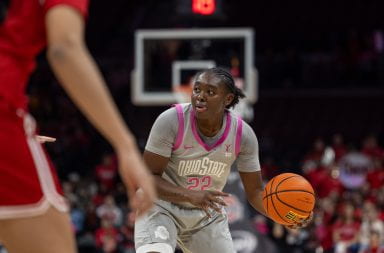
Junior corner back Denzel Ward (12) tackles Taivon Jacobs of Maryland during the Ohio State game on Oct. 7 at Ohio Stadium. Ward was ejected immediately after for targeting. Credit: Sheridan Hendrix | Oller Reporter
Ohio State head coach Urban Meyer said the Big Ten admitted to him that its controversial targeting penalty called on junior cornerback Denzel Ward Saturday during the Buckeyes’ 62-14 win over Maryland was incorrect.
“What you do is you turn [the video] in each week and I’ll have a guy on our staff call the Big Ten officiating and then report back was that you know on the field, it’s a snap judgment, but replay official was in error,” Meyer said Tuesday on the Big Ten coaches teleconference. “And so we’re going to reward Denzel Ward today at practice for a caused fumble and he should not have been ejected. And it was a mistake.”
Meyer said the biggest concern he has is that a call of that magnitude could be made in a more important game, like the Big Ten championship, where the loss of his top corner could affect his team’s chances of winning.
“Oh, concerned, irate, all the above,” Meyer said. “I just don’t understand how that happens. But that’s for the higher-ups to figure out. Yeah, of course. Concern is probably not strong enough.”
Ward laid a hit on Terrapin wide receiver Taivon Jacobs that knocked the ball loose. The junior cornerback appeared to lead with his shoulder on the hit and drive into Jacobs’ chest, but the call on the field was that it was a targeting call. A short video review later confirmed the ruling on the field and Ward was ejected from the game.
Cornerback Damon Arnette was ejected later in the game with the penalty, but he was clearly deserving of being called for targeting as he hit Maryland quarterback Max Bortenschlager in the head or neck area as the sophomore signal-caller was sliding.
The Lantern reached out to the Big Ten for comment on the Ward targeting call.
The consequence for targeting is for the immediate disqualification of the player and a 15-yard penalty if video review confirms or upholds the targeting call on the field. If the incident happens in the first half, the player will be disqualified for the remainder of the game and miss no further time beyond that. If the penalty happens in the second half — as it did with Arnette — the player will miss the remainder of the game and the first half of the following game.
The NCAA defines targeting as the following:
Targeting and Making Forcible Contact With the Crown of the Helmet
ARTICLE 3. No player shall target and make forcible contact against an
opponent with the crown (top) of his helmet. This foul requires that there
be at least one indicator of targeting (See Note 1 below). When in question,
it is a foul. (Rule 9-6) (A.R. 9-1-3-I)
Targeting and Making Forcible Contact to Head
or Neck Area of a Defenseless Player
ARTICLE 4. No player shall target and make forcible contact to the head
or neck area of a defenseless opponent (See Note 2 below) with the helmet,
forearm, hand, fist, elbow or shoulder. This foul requires that there be at
least one indicator of targeting (See Note 1 below). When in question, it is
a foul (Rules 2-27-14 and 9-6). (A.R. 9-1-4-I-VI)
Note 1: “Targeting” means that a player takes aim at an opponent for
purposes of attacking with forcible contact that goes beyond making
a legal tackle or a legal block or playing the ball. Some indicators of
targeting include but are not limited to:
• Launch—a player leaving his feet to attack an opponent by an
upward and forward thrust of the body to make forcible contact in
the head or neck area
• A crouch followed by an upward and forward thrust to attack with
forcible contact at the head or neck area, even though one or both
feet are still on the ground
• Leading with helmet, shoulder, forearm, fist, hand or elbow to
attack with forcible contact at the head or neck area
• Lowering the head before attacking by initiating forcible contact
with the crown of the helmet
Note 2: Defenseless player (Rule 2-27-14):
• A player in the act of or just after throwing a pass.
• A receiver attempting to catch a forward pass or in position to
receive a backward pass, or one who has completed a catch and has
not had time to protect himself or has not clearly become a ball
carrier.
• A kicker in the act of or just after kicking a ball, or during the kick
or the return.
• A kick returner attempting to catch or recover a kick, or one who
has completed a catch or recovery and has not had time to protect
himself or has not clearly become a ball carrier..
• A player on the ground.
• A player obviously out of the play.
• A player who receives a blind-side block.
• A ball carrier already in the grasp of an opponent and whose
forward progress has been stopped.
• A quarterback any time after a change of possession
• A ball carrier who has obviously given himself up and is sliding feet-first.


